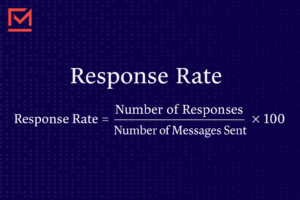Same Experts. New Name.
SeQuel Response and FM Engage are now Franklin Madison Direct. While our name has changed, everything else remains the same: our people, our process, and our passion for driving measurable results through direct marketing.

Blog
When direct mail response rates start to plateau or fluctuate, it’s rarely random. It’s usually a sign that something in your targeting, creative, or offer strategy has grown stale or misaligned with your audience.
If you’re not measuring with precision, small drops can go unnoticed until performance is already in decline. Knowing how and when to recalibrate is what separates steady senders from real-scale performers.
| Prefer to listen? Check out our podcast The Direct Effect: Direct Mail Response Rates: What You Need to Know |
Direct mail is a response channel built to generate action, such as calls, clicks, conversions, and purchases. That is why response rate is more than a vanity metric. It is a clear signal of whether your message landed, your audience was targeted correctly, and your timing was right. Response rate answers the question: did this campaign do what it was supposed to do?

Here’s where many mailers fall short: they only track the obvious responders, QR code scans, promo code users, and the PURL (personalized URL) visitors. In reality, most mail-driven conversions happen outside those touchpoints. Matchback analysis (comparing your mailing list to post-campaign transactions) often digs much deeper.
When only looking at direct attribution, you’re underreporting results and potentially optimizing around the wrong metrics.
What qualifies as a “good” response rate? It depends—industry, audience quality, and offer complexity all play a role. Some industries may lean higher or lower depending on how the response is defined.
For instance, campaigns asking for a purchase or detailed form submission typically see lower response rates than those inviting a simple opt-in, especially when friction is removed with tools like pre-filled, postage-paid reply cards. That’s why response rates are only part of the story.
Many marketers focus on customer response, especially teams aiming to measure customer engagement. However, there is another metric that should not be ignored: sales rate.
In direct mail marketing, sales rate refers to the percentage of recipients who respond to a campaign and go on to make a purchase. It is a more precise measure of ROI (return on investment) than response rate, which captures all forms of engagement, including inquiries, sign-ups, or other non-purchase actions. On average, direct mail sales rates fall between 0.25% and 1%.

While response rate is often used as a top-line metric to gauge campaign engagement, it doesn’t always correlate with revenue. A piece may generate a high response rate but convert poorly to sales, making the campaign less profitable. Sales rate, by contrast, directly reflects a campaign’s effectiveness at generating revenue.
Despite this distinction, many in the industry treat response rate and sales rate as interchangeable terms, which can obscure the true financial impact of a campaign.
As a performance-driven agency, Franklin Madison Direct focuses on measurable outcomes, and sales are the ultimate goal for many clients. While response rates are useful for testing messaging and gauging interest, sales rates are what ultimately justify continued investment.
Audience targeting is often the biggest lever you haven’t fully pulled. Even mailers with solid data strategies can end up using the same models quarter after quarter, but audiences shift and intent changes. If your data inputs don’t reflect that, direct mail performance suffers.
Smart mailers blend first-party data with third-party behavioral and demographic overlays, creating precise and scalable audience profiles. For example, lookalike models built from converters can outperform even well-curated prospect lists. When your time drops around key behavioral signals—credit triggers, seasonal spikes, or even recent digital activity—you’re reaching the right people at the right moment.
FM Direct helped a home warranty brand review data suppression strategies, identifying 15% more records from the brand’s strongest prospect sources. This led to a 60% jump in sales rate, all without inflating costs.
This level of precision allowed this home services brand to uncover new pockets of opportunity, far beyond what standard targeting can deliver.
“Smart mailers blend first-party data with third-party behavioral and demographic overlays, creating precise and scalable audience profiles.”
The structure of your mail piece matters more than most marketers realize. A flashy format doesn’t guarantee performance, and sometimes, simplicity converts better. That’s because format impacts how your message is received, understood, and acted on.
Don’t forget: performance depends on your brand, audience, and offer. Just because a letter format drives a higher sales rate for one brand doesn’t guarantee it will for yours. A format that signals authority to one audience might feel overly formal or intrusive to another. That’s why the best thing to do isn’t to assume, it’s to test.
It’s important to remember that you’re talking to a person (not just a segment). The more your message feels meant for them, the more likely they will respond. Rather than inserting their first name in bold red letters, show that you understand their priorities, timing, and what matters to them now.
Creative that reflects identity tends to outperform creative that just highlights product features. Messaging should frame the recipient as the protagonist, meaning someone intelligent, capable, and making a timely decision. When that happens, a credit offer becomes empowerment, a healthcare plan becomes peace of mind, and a home service becomes a wise investment. It’s all in the framing.
There’s a difference between testing and guessing. Too many campaigns “test” new ideas without isolating variables or measuring lift correctly. Real testing requires structure. Use control groups, stagger drop dates, and don’t rush analysis. Most responses come in within four weeks of in-home delivery, but strong trailing performance can be seen for up to 90 days depending on the category.
The smartest programs treat testing like compound interest. A 10% lift on a control might not sound like much, but do it again, and again, and you’ve doubled performance within a few cycles. Small wins, consistently applied, lead to significant outcomes.
Your audience doesn’t live on a marketing calendar—they live on a psychological one. Tax season, school enrollment, home renovation cycles, and open enrollment windows all shift mindsets, urgency, and attention. Aligning your message with these moments makes your offer feel relevant now.
We’ve seen sales rate lift significantly when campaigns are aligned with real-life moments. Even a subtle shift, like moving a drop from early January to late December, can change the perceived urgency of an offer. That calibration level separates mail that gets glanced at from mail that gets action.
Direct mail’s strength isn’t just that it reaches people. It’s that it reaches the right people, with the right message, in a meaningful and human way. If your campaigns aren’t delivering the results you expect, the solution probably isn’t a bigger budget. Perhaps it’s sharper targeting, clearer messaging, smarter format decisions, more intentional testing, and a feedback loop that doesn’t settle for “good enough.”
You know the value is there. Unlock it now by starting a test.